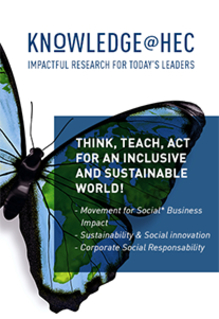watch the masterclass:
1. What is ESG?
ESG stands for Environmental, Social and Governance. It is the translation of Corporate Social Responsibility (CSR) or Sustainability for Finance people. The word is at present on every finance person’s lips. First coined in 2005 by United Nations Environment Programme Initiative in the Freshfields Report, “ESG” mostly enabled the emergence and scaling of a sustainable investment industry. It is very much the investment world which “captured” the acronym. Within companies, it has been a much slower emerging process. At L’Oréal for instance, the CSR department emerged in 2012, however it was only in 2020 that we saw Sustainable Finance VP and Department created which include ESG issues.
2. Why do companies develop these metrics?
Companies develop these metrics to comply with the regulations, especially in the EU, to answer their investors’ needs and to manage their sustainability performance. Investors want to be able to compare across companies, to secure their investments, and mostly they want to know whether their assets will still be valuable in 15 or 20 years. For example, when they invest in Oil & Gas majors: what will be the market for fossil fuels in 15 years? Volumes and prices? Same with the automotive industry: will current major players still be alive in a market of 100% EVs?
Investors want to secure their investments, companies want to measure their GHG emissions to reduce them.
Beyond answering their investors’ needs, for companies who want to set targets and reduce their GHG emissions, it starts with knowing how much their GHG emissions are and keeping track of them. You get what you measure.
3. Why are there some allegations of greenwashing against ESG?
A quantification that is yet to be unified
Despite regulations and reinforced transparency demands, ESG metrics are still very much free of interpretation and adaptation. There is not even a unified definition of sustainability, and no unified definition of environmental (E), social (S) or governance (G). There is no convergence either on the specific KPIs to be used in each dimension: is “S” about equal rights and discrimination or is it about wages and work conditions?
A lack of convergence
The calculative methodologies lack of homogeneity. For example, some companies report in scope 1 only (their own emissions) while other report in all scopes 1, 2 and 3a-3b (their own emissions plus those of their value chain). The aim is to include scopes 2 and 3, however practices still vary a lot due a lack of reliable data. In regard of lack of convergence in sustainability reports, see HEC Paris Professors Luc Paugam and Hervé Stolowy's paper, Sustainability reporting: is convergence possible?, published in 2023 in Accounting in Europe.
A social construction
ESG metrics reflect social and “political” preferences and logics. They are the outcome of a process of building compromises and negotiating, which is still taking place.
In this process investors are a major stakeholder. However they see ESG performance as a way to generate long-term financial performance, not as a goal in itself (make this planet a more habitable one). For instance, in the ongoing debate about double materiality, investors are mostly interested in financial materiality, and less in impact materiality. Another example: in their voting recommendations to the GA, investors are mostly interested in the G, increasingly interested in the financial risks related to the E, and minimally interested in the S. Besides, on the global chessboard, this social construction sees major differences across regions, between Europe and North America for instance. They reflect the weight of investors in the said region. For instance, in the EU, reporting norms, which insist on the double materiality, are mandatory and publicly developed as an extension of the Corporate Sustainability Reporting Directive (CSRD); at the opposite North-American and British companies – when they report on ESG, find the private sustainability standards issued by the International Sustainability Standard Board (ISSB), based on financial materiality and voluntary disclosure, more attractive. In regard on the effect of EU regulations on businesses, read this article by Marieke Huysentruyt, HEC Paris Professor of Strategy and Public Policy: How Will New European ESG Reporting Standards Affect Companies?
In sum, there is a high risk that ESG as understood by investors, and by companies in their Investors’ Relations, will not save the planet… This explains the allegations against ESG as a “greenwashing tool”. There is a need to build a larger compromise on ESG metrics with all stakeholders (society at large, citizens, employees, consumers). However, this process takes time, and difficult compromise building.
4. Still, measuring matters!
Why is ESG reporting still important despite the current lack of convergence? In what way is it essential to avoid greenwashing? Despite allegations - sometimes legitimate - of companies greenwashing by my younger students at HEC Paris, I believe that businesses must be part of the solution. It takes regulators and public policies to improve the situation. It takes individual commitment and behavioral change to progress. But it also takes a major business transition. ESG metrics are helping the companies who want to do better, and accounting for sustainability has huge virtues.
Metrics are important for setting targets, for taking a path. Metrics are important for managing sustainability performance. Sometimes the same companies who are “dancing/window dressing ESG” in front of the investors are also trying to do good. For example, for carbon/GHG, many companies have engaged in decarbonization strategies. They have improved their accounting methodologies and their data collection. They have involved their CFOs, and as a consequence, environmental performance is invited to business reviews and meetings and becomes a topic that must be managed. GHG emissions can be budgeted and monitored just like costs and euros.
5. The need for a change in business models
I call my students in business to encourage and drive action, not just to critically discourage it. It is good to denounce, but it is even better to act.
Decarbonization strategies are a first step. However, they are not sufficient: for instance when you are in the oil & gas or cement industries, you can produce O&G or cements in a more decarbonized way, however in scope 3, it looks terrible, because you are still operating in fossil fuels or cements. Decarbonization is mostly about doing what you have always done, just in a more climate-friendly manner, for instance by sourcing more sustainable materials.
The second step is to shift your business model. This is far more impactful, but also far riskier, and usually longer term. In oil & gas, you probably need to transition to renewable energies if you want to stay in business in Europe in 15 years’ time. In many industries shifting your business model means moving towards the circular economy. For example, a global leader in carpet and flooring solutions, has engaged in innovative business models and innovative materials that they will be able to recycle at the end of product life.
The third step: a few regenerative companies have pledged to generate positive externalities. They have developed detailed roadmaps and KPIs to do so. Admittedly, many of the regenerative companies are B-Corp companies, and it is easier to become a regenerative company for family-owned businesses, protected from the disciplines of financial markets.
ESG KPIs and metrics are key in taking this path, provided there is more to it than the investor-dominated approach of ESG.
In sum, ESG metrics are challenging, not flawless, and like any accounting device, ESG is a social construction currently at work with a lot of divergence. However, we absolutely need them for setting targets and for improving the situation. Doing good in terms of ESG will require more than window dressing, it will take major shifts in the business models of most industries. Action is required and ESG metrics can help in measuring action.
Find more references to learn:
On Sustainable Accounting:
Laine, M., Tregidga, H. & Unerman, J., 2022, Sustainability Accounting & Accountability, 3rd edition, Routledge.
Gray, R., 1994, Corporate reporting for sustainable development: Accounting for sustainability in 2000 AD, Environmental Values, pp. 17–45.
Schaltegger, S., Zvezdov, D., Etxeberria, I.A., Csutora, M. & Günther E. (eds), 2015, Corporate Carbon and Climate Accounting, Springer.
In French:
David B. & Giordano-Spring, 2022, Connectivité entre le reporting financier et extra-financier: une exploration à travers la comptabilité climat, Comptabilité-Contrôle-Audit, 4:28 p.21-50.
Renouard, C. & collectif Fortes, 2020, Nomos : mesurer, réguler et gouverner, p.145-170, in Manuel de la Grande Transition, LLL Editions.
On Climate and Impact:
Cohen, R., Sir, 2020, Impact: Reshaping Capitalism to drive real change, Ebury Press.
Gates, B. 2021, How to avoid a climate disaster, Knopf Penguin Random House.
Henderson, R. 2020, Reimagining Capitalism in a World on Fire, PublicAffairs Hachette Book Group.
In French:
Jancovici, J.M., The Shift Project, 2022, Climat, crises : le Plan de Transformation de l’Economie Française (PTEF), Odile Jacob.
Lacy, P., Long, J., & Spindler, W., 2021, Le manuel de l’économie circulaire : mettre en œuvre les avantages de l’économie circulaire, MA Editions.








